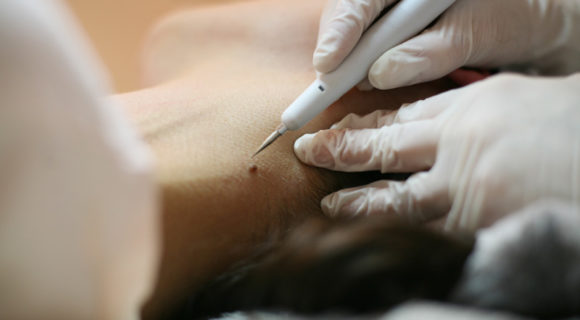What is Laser Mole Removal?
Without a doubt, one of the recommended modern methods in removing moles is via laser treatment. The essence of the treatment is in light radiation breaking down the cells of the mole. When people hear radiation, they think of the harm that it does to the body; however, it is crucial to note that the level of radiation that is used in this treatment is not high whatsoever, therefore not dangerous. This treatment is also truly precise due to it not doing damage to the surrounding tissues.
What Type of Moles Are Most Suitable for Laser Treatment?
In most cases following a skin tag removal procedure, the skin would get sent to the lab for biopsy. Laser treatment would prevent this process due to its nature of fully damaging the skin tag. If a person has multiple moles and the biopsy one of the moles returns negative, then laser treatment is the most ideal option for the remaining moles on the body.
Generally, small moles are ideal candidates for mole removal via laser treatment. Treating larger than usual moles by lasering may not be effective because if the mole is larger than the scope of the laser, then treatment would face difficulties.
The majority of dermatologists believe that this treatment option is suitable for moles that are located in hard-to-reach areas, such as the ears. Using the cutting method for moles located inside the ear canal for instance would be inconvenient.
What Advantages Does Laser Removal Have Over Other Treatment Options?
One of the advantages of mole removal laser treatment compared to other treatments is in its shorter duration. It will only take your dermatologist a few minutes to laser off your mole and then right after you can be on your way.
Another major advantage of this treatment over others is the fact that it is non-invasive meaning that there is no cutting or burning the skin involved. This reduces the chance of skin infection, as well as a boost in skin recovery.

What Other Ways Can I Have a Mole Removed?
In addition to the laser treatment, there are two other common methods in which moles are removed. One being surgical excision which means cutting out the entire mole following with stitches. The second method being shaving off the mole using a surgical blade. Both of these procedures are invasive unlike the laser removal procedure.
Why Do People Have Moles Removed?
There are various of reasons behind why people opt to remove their moles. Some do it for cancer concerns as their moles could either be cancerous or have the potential to cause cancer. There is also a cosmic factor involved as many lean towards mole removal for a better appearance. Some do it simply because their moles cause discomfort when they rub against clothing or get caught in jewellery.
How Can I Tell if a Mole Needs Medical Attention?
In most cases if your mole is indeed threatening your health, your body does show you signs that you could observe. For instance, if you notice any changes in the size, shape, colour, and the thickness of your mole, you should contact a dermatologist. If there are multiple colors on a single mole, that could be concerning.
In most cases a cancerous mole has one fixed color alongside with shades of another colour. Also, in terms of the shape of a mole, if the edges are irregular then there may be a case of concern there.
How Many Different Types of Moles Are There?
The three main types of moles are congenital moles, common moles, and atypical moles. Congenital moles are moles that appear on the skins of infants. The recipients of this type of mole are mostly born with it. Close to 2% of all infants are reportedly born with a congenital mole.
Common moles are moles that appear on your skin following birth. They can appear anywhere on your skin. They are mostly really small and tend to maintain their form. Reports of common moles changing form are really rare. It is normal for people to have between 1 to 40 of these moles on their skins. If the number exceeds 40, the person should visit a physician for further examination because in most cases having such a common mole count means a higher chance of getting cancer.
Atypical similar to common moles appear after birth and they also tend to be non-threatening; however, in some cases atypical moles turn into melanoma cancer. The chances of atypical moles turning into cancerous cells are still fairly low as it is estimated that 1 in 10,000 atypical moles turn into cancer.
Frequently Asked Questions (FAQ)
Do moles ever come back after being removed?
In most cases a mole after its removal does not come back. If a mole reappears, that means the cells of that mole were not fully destroyed by your dermatologist. If a dermatologist fails to cut out all the components of a mole, that mole could come back after a removal procedure. In most cases, this does not happen, but it is possible.
Can I remove my mole myself?
Please do not remove your mole at home. It could lead to bleeding and even worse, it could cause infection. Please talk to your doctor and see what your options are in regard to your issue. With NewM Clinic dermatologists it will take only one session to fully remove your mole. Please visit Removing Skin Tags and Moles at NewM Clinic website and learn more about our treatment methods.





